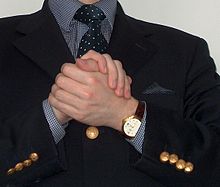Blazer (garment)
The Blazer is a sporty jacket shape for men, women and children, without binding rules of the cut, single-breasted or double-breasted, with rising or falling Fasson ( lapel shape ). An essential style element of traditional blazers is the coat of arms (French: Blazon) on the breast pocket. The classic blazer also differs in the more original forms from sports coats or suit jackets mainly through shiny metal buttons and through the use of colors and fabrics from the tradition of uniforms.
Origin of the name
Despite sources to the contrary, it is unlikely that the term first came about in 1837 during a visit by Queen Victoria on the HMS Blazer. There are no contemporary sources for it; the first mention of the term in the Oxford English Dictionary is is a better explanation from 1880, that the name of the flaming red uniform jackets of Lady Margaret Rowing Club from St John's College in Cambridge (see below) comes (Engl. to blaze " blaze, flare up, light up, sparkle, shine ”).
First of all, there is the two-row navy blazer , mostly made of worsted wool . It is always navy blue and has twelve gold-colored buttons, often with an embossed coat of arms, of which six are large on the front. It has one chest pocket, two flap pockets and two side slits . Historically, he goes to British naval jackets of the 19th century back. According to a widely published opinion, the Navy Blazer owes its name to this origin: The jacket is said to have been made for the first time in 1837 on the occasion of a visit by Queen Victoria on the frigate HMS Blazer . Due to royal approval, it initially found its way into the entire navy and later also found its way into civilian men's fashion, in which it has a difficult position today due to its hybrid position between formal and informal wardrobe. It should be noted, however, that there are apparently no contemporary written sources for this theory.
Single-breasted
There is also the single-breasted blazer, which has its roots in the club jackets of the English rowing clubs . Unlike the navy blazer, it doesn't have to be dark blue; the jackets of the Lady Margaret Boat Club at St John's College in Cambridge are even flaming red. In general, colors other than dark blue have hardly caught on even for single-breasted blazers. The second most popular color is black.
He wears eleven gold-colored buttons, three of them on the front. Some of the gold buttons have been replaced by blue or enamel buttons, which, however, threatens to blur the specific character of the garment.
Originally provided with three patch pockets, it was mostly adapted to the navy blazer in this regard and is now mostly cut with flap pockets. There are no binding rules for the cut.
In its single-row form, the blazer is part of numerous school uniforms in Anglo-American countries, as well as a popular leisure jacket that is often worn with flannel , chinos or jeans .
Synonymous with sports jacket
More recently, “blazer” has also been used as a term for any buttoned sports jacket.
literature
- Ingrid Loschek: Reclam's fashion and costume lexicon. 5th edition Reclam, Stuttgart 2005, ISBN 3-15-010577-3 , p. 122f.
- Bernhard Roetzel: The gentleman. Manual of classic men's fashion. Cologne 2009, ISBN 3-8331-5269-9 , p. 146 f.
See also
Web links
Individual evidence
- ↑ Alfons Hofer: Textile and Model Lexicon . 7th edition, Volume 1, Deutscher Fachverlag, Frankfurt am Main 1997, keyword “Blazer”. ISBN 3-87150-518-8 .
- ↑ http://fashion-history.lovetoknow.com/clothing-types-styles/blazer
- ↑ http://www.oed.com/view/Entry/20013?rskey=hAd6HA&result=1&isAdvanced=false#eid
- ↑ Blazer indication of origin at Duden.de

